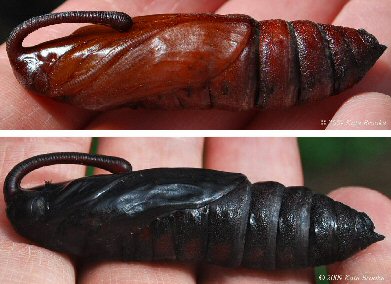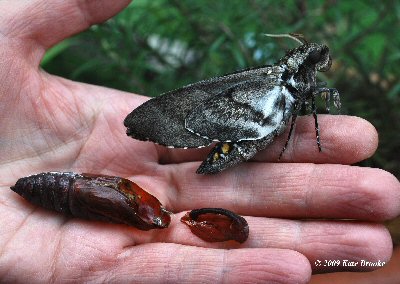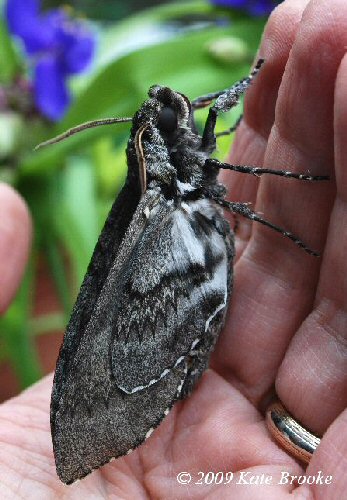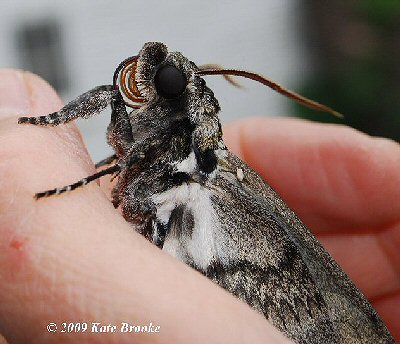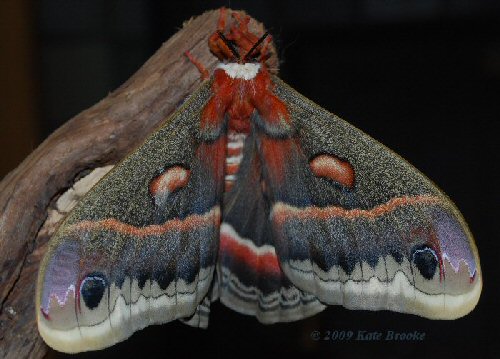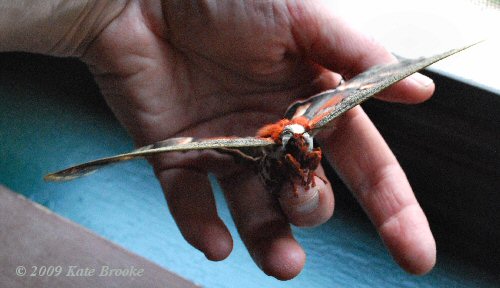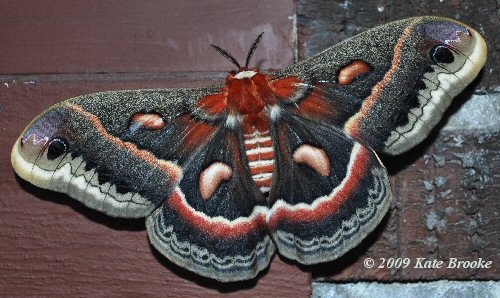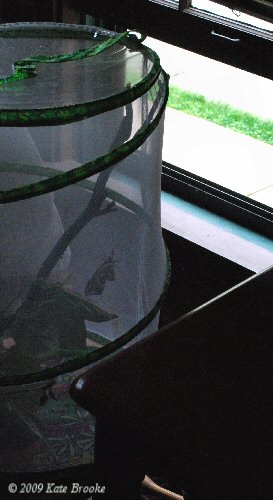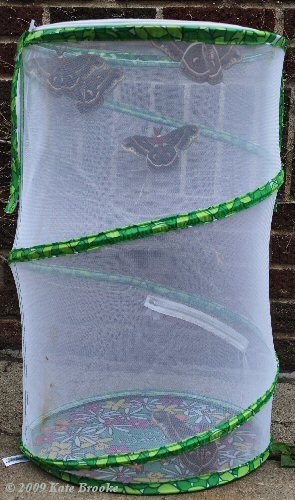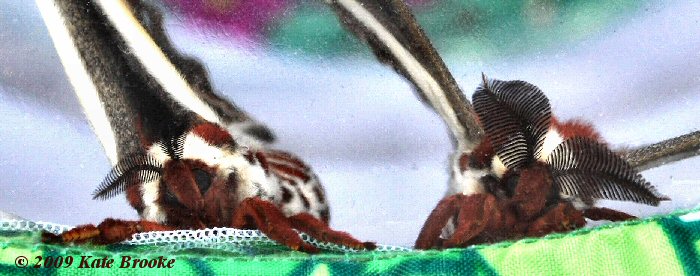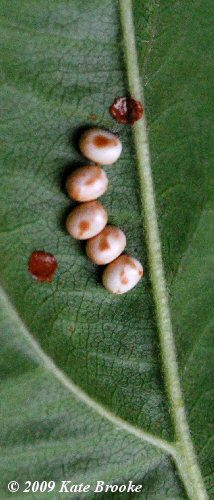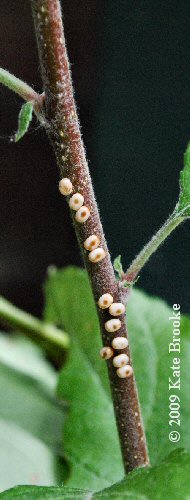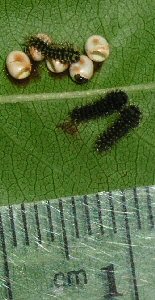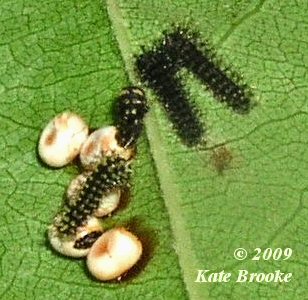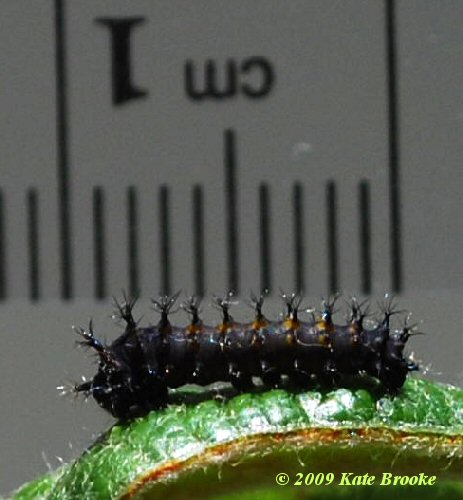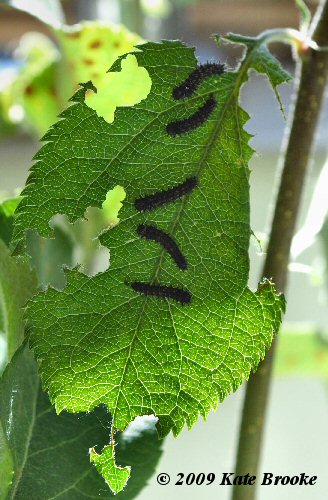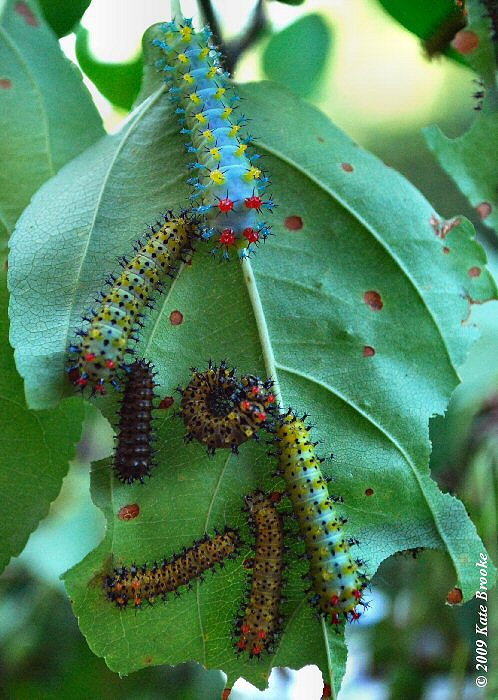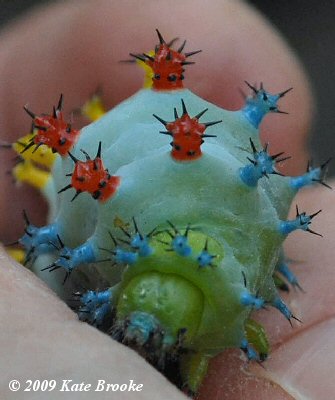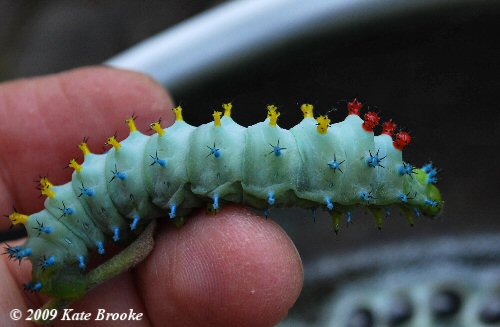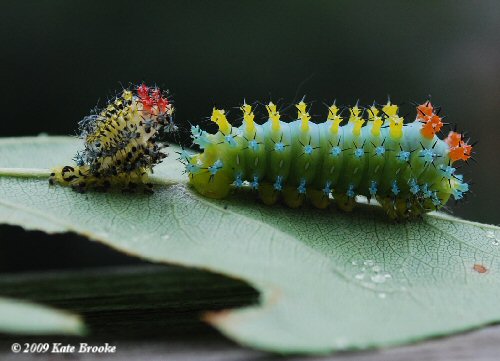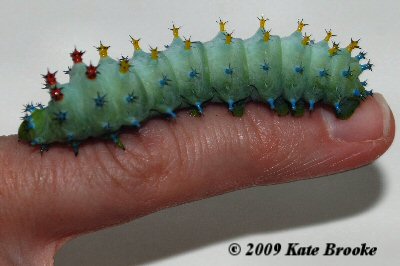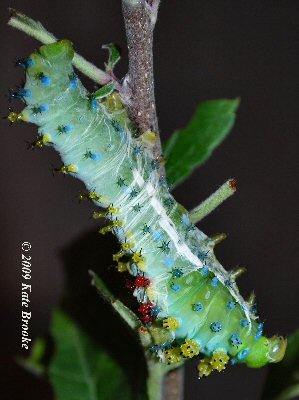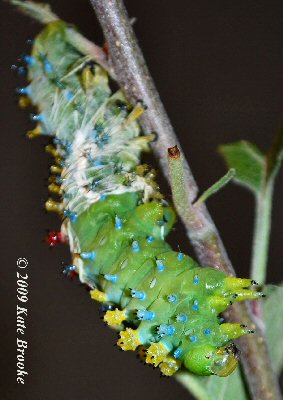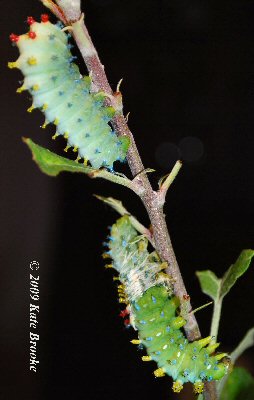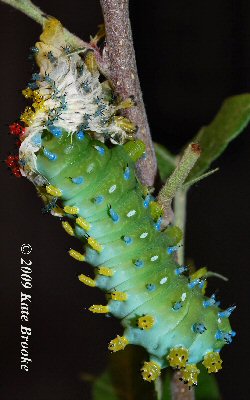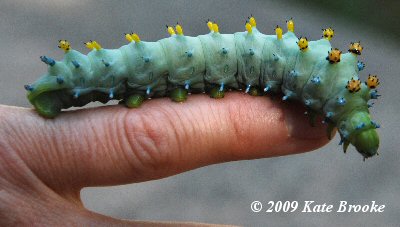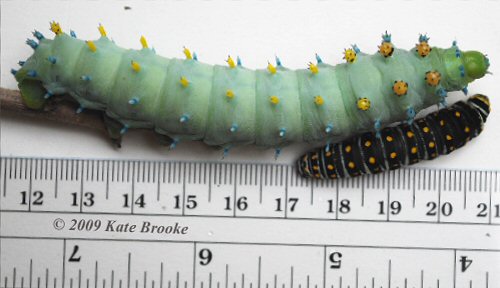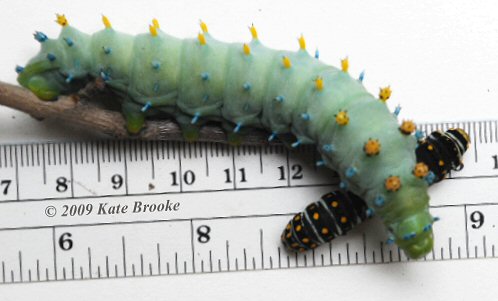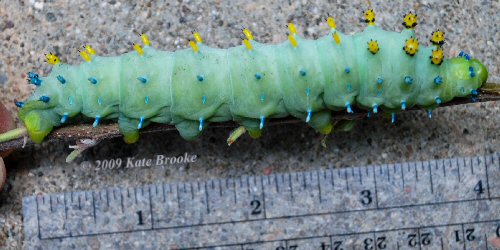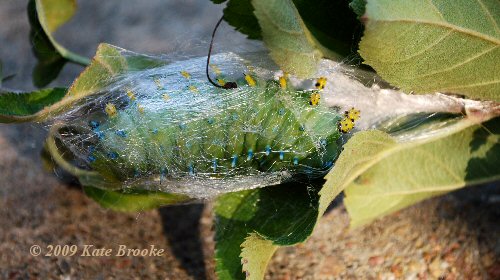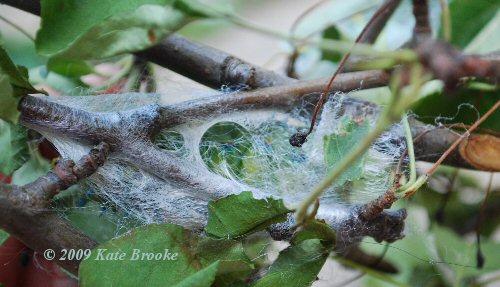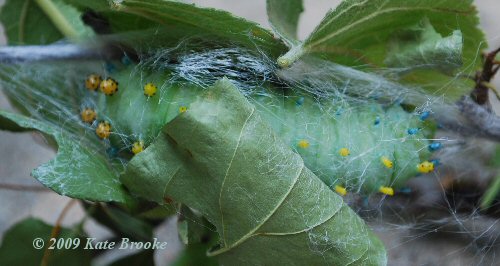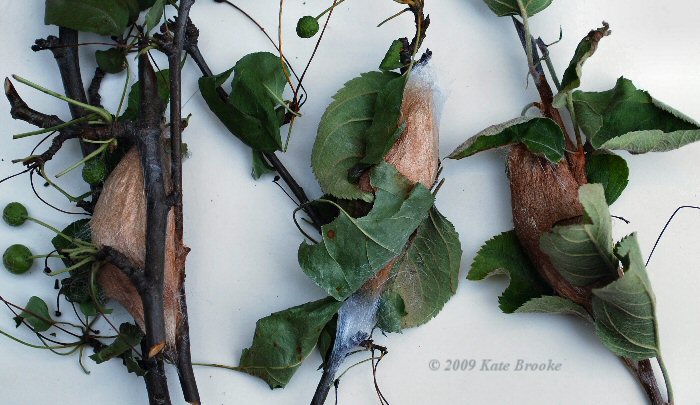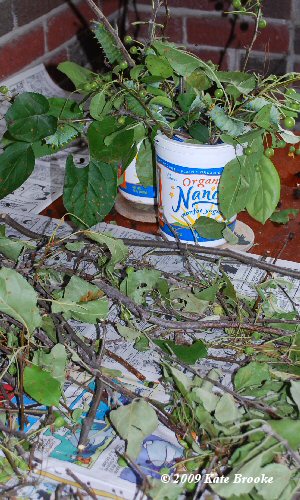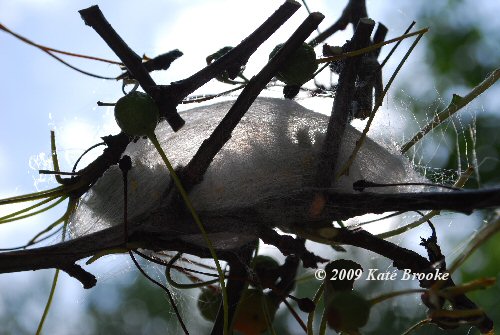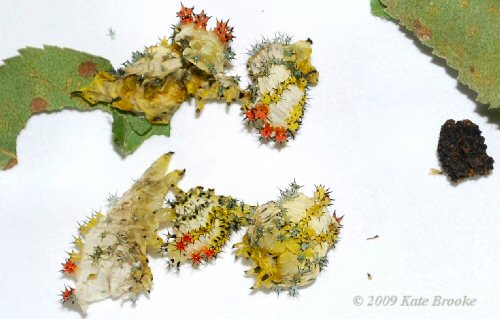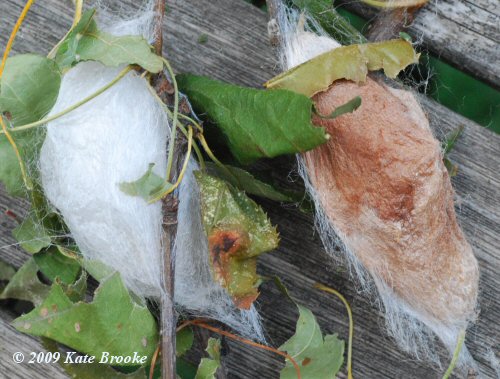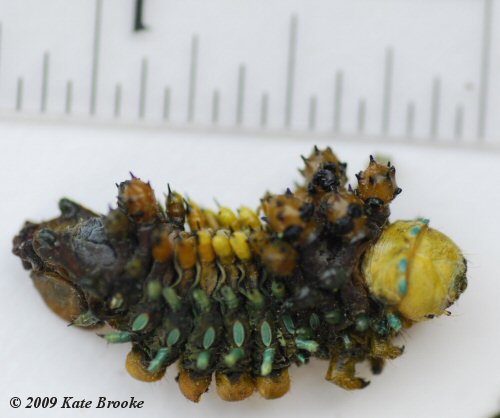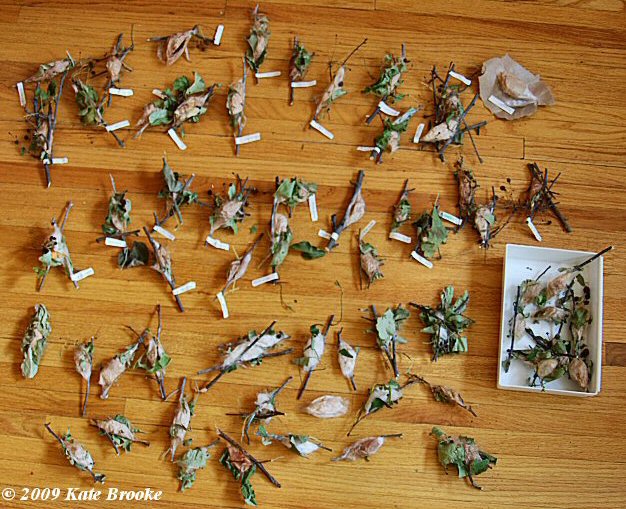| |
Spring and Summer 2009 |
|
|
Above and below: a Sphinx Moth, overwintered in my studio in its pupa stage (above left). A few days before the moth emerged, the case turned dark and I could see spots through the sides. The moth emerged on the afternoon of June 9th and was released that evening. For several hours after it emerged, the moth was quite docile and cooperated with me for photographs. |
|
|
|
A Cecropia Summer |
|
|
| |
|
| |
|
| |
|
| |
| |
June 13, 2009: the photographs below demonstrate the power of pheromones. I kept the female moth overnight inside a mesh insect cage on my enclosed porch, leaving one window open and without a screen (below left).
I thought it would be neat to capture a male cecopria moth and maybe raise a few caterpillars this summer.
As it turns out, the female attracted at least four males that night. I kept all four males for a day (below right),
then released three males, keeping the female and her chosen mate. |
|
|
| |
|
Above: the female cecropia moth is on the left and a male is on the right. The female has a much larger abdomen
than the male because she carries eggs. The male has much larger antennae than the female so he can detect
her pheromones and locate her. Below are some of the eggs from this pairing of cecropia moths (June 15, 2009).
On the left the eggs are on a crab apple leaf (complete with rust), and on the right the eggs are on a stem from an apple
tree. In about ten to fourteen days the eggs would hatch out into caterpillars. |
|
|
| |
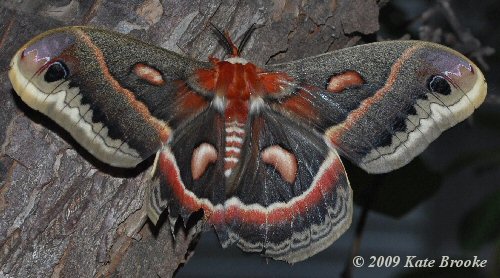
A final photograph of the female cecropia moth released onto my crab apple tree at dusk. Minutes later she took flight.
Despite her torn wing, she caught the wind and flew above the houses across the street to the south. |
| |
On June 22nd I divided the eggs into three groups. One group I moved to our screened in porch where the eggs would be kept warmer. A second group I placed in the refrigerator to slow down their development. The third group remained in our dining room. I thought it would be a good idea to stagger the hatches so that I wouldn't be overwhelmed with caterpillars to feed. Wednesday, June 24, 2009: the first round of Cecropia Moth eggs is hatching on the porch.
Both apple and crab apple seem to keep quite well. I poked holes in the lid to a yogurt container so I could keep the stems watered without letting the caterpillars drown themselves easily. Each day I changed the water and trimmed the stems.
On the morning of June 24, the porch eggs were hatching. I brought them into the dining room and cut fresh apple and crab apple. By the end of the day, I wasn't sure any of the caterpillars were eating.
June 25: by 8:00am the dining room eggs began to hatch. |
|
| |
| |
|
| |
|
|
| |
Now it is about 4:00 on the 25th, and I am seeing evidence that at least some of the caterpillars are eating. Both apple and crab apple leaves seem to be munched on, although I am seeing more interest in the apple. I have one container with apple and another with crab apple, and the two are close enough that the foliage touches. That way, I figure the caterpillars can pick whichever one it prefers. I understand once they start eating something, they do not care to change. I might see if I can add pear to the mix for the next hatching (I still have eggs in the 'fridge). |
|
| |
| |
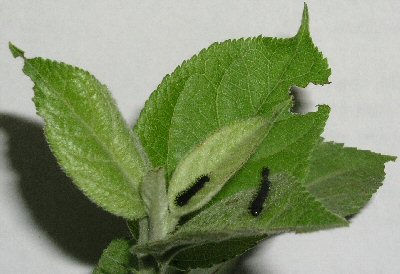 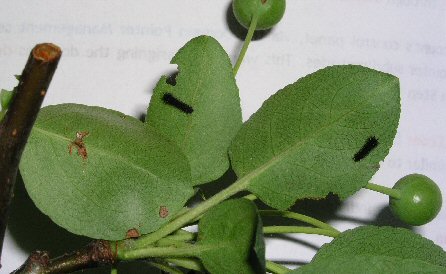 |
Left: apple; right: crab apple. |
| |
| |
|
Monday, June 29: the cecropia moth caterpillars are doing quite well on apple and crab apple leaves.
Now they have doubled their size from .5cm to 1cm. |
| |
|
July 19, 2009: the caterpillars are thriving. Some (not pictured here) are in their fifth instar and soon should be forming cocoons. The above caterpillars represent three or four of five instars. With so many caterpillars eating at the same time, leaves disappear quickly. If I am quiet, I can hear the caterpillars eating. Sometimes a smaller caterpillar will be on the tip of a leaf upon which a larger caterpillar also is feeding. Later I will find the smaller caterpillar, still clinging to its portion of leaf, but down on the table where it fell when the larger caterpillar had eaten away all connecting parts of the leaf. . |
|
| |
|
My father loves seeing pictures of insects from the front. |
| |
|
| |
| |
|
Moving from one instar to the next; later the caterpillar ate the old skin. |
| |
|
This is what I mean when I describe the cecropia moth caterpillars as growing to be almost the size of my little finger. |
| |
| |
Below: I believe this bruiser is moving into the final (fifth) instar. Notice that it no longer has the four bright red spots. |
|
|
| |
| |
|
Same finger, larger caterpillar. This one easily is three inches long. |
| |
July 27, 2009. This is a first: this morning I gave all the cecropia moth caterpillars fresh leaves to munch on. When I went to check on them in the afternoon, I found at least a dozen of caterpillars from the later hatch group wandering about on the floor beneath their table. I cut more fresh leaves for them, but some continued to abandon their food source so I confined them to a mesh cage. This later hatch group is comprised of caterpillars still mostly in third and fourth instars. Curiously, the first hatch, most of which now are in their fifth instar, still are contentedly eating. Those are the ones I expect soon will wander in order to find places for their cocoons. |
|
| |
|
For fun and for scale: a fifth-instar cecropia moth caterpillar with a fifth-instar black swallowtail butterfly caterpillar.
Minutes after I took this picture, the black swallowtail butterfly caterpillar made its little sling in preparation for moving
into its chrysalis stage. For its part, the cecropia moth caterpillar resumed eating. July 28, 2009 |
|
|
The two caterpillars mostly ignored each other. This contact was coincidental.
The black swallowtail butterfly caterpillar is particularly dark. Usually they are a much brighter green. |
| |
| |
|
We have four-inch caterpillars! |
| |
| |
August 3, below: three of the caterpillars from the first hatch started making their cocoons: |
|
|
|
| |
| |
|
August 4: the three cocoons as they now look from the outside. Goodness knows what is going on inside. The caterpillars
continue to be active, and I can hear them moving about and . . . touching up the interior decor? Eating remnents of leaves caught inside the cocoons? I had assumed they immediately would become dormant, but apparently that is not so. |
|
| |
| |
|
| |
| |
|
| |
| |
|
| |
| |
|
Above: when the cecropia moth caterpillars get so large that I think soon they might make their cocoons, I move them onto a separate table with their own fresh leaves to eat. By accident I found out that when I leave the leftover stems in small heaps on the table with the fifth instar caterpillars, more likely than not they will use those stem piles for their cocoon sites. The caterpillars seem to start making a cocoon late in the day, then do most of the work on it overnight. In the morning I cut short the stems holding the cocoon so I can move it to a different site. Newspaper underneath makes it easier to move a cocoon to another location once it's been made (I give them the funnies). Another arrangement I tried was to put the caterpillars with some fresh leaves into a brown paper grocery sack, folding the sack closed at the very top (two folds). I clipped the top, then checked them each day, adding more leaves when needed. This allowed the caterpillars to make their cocoons where I knew where to find them. The down side was I didn't get to observe them. Although it means doing a caterpillar roundup once or twice a day, I prefer having them loose on my porch. The porch will remain cold enough over the winter that I doubt any moths would emerge prematurely from any cocoons made on the walls. (Note: only one moth made its cocoon on the wall.) |
|
| |
| |
|
Above: one of the cocoons cut free from the twig pile. This one was only partly finished, and I could see the caterpillar busy at work inside. |
| |
| |
| |
|
Above: part of my collection of cecropia moth caterpillar
paraphernalia: bits of munched leaves,
caterpillar pyjamas (the exoskeleton that is shed between instars), and, yes, frass. |
| |
| |
On August 24th, I had the opportunity to visit all four second grade classrooms at Pyrtle Elementary. These second graders were about to host painted lady butterflies, and the teachers were eager to also have cecropia moth caterpillars in their classrooms. I spent about twenty minutes with each class, showing the students cecropia moth caterpillars and telling them about my summer's adventures with them. Each class kept three of the caterpillars to nurture to the cocoon stage. This was one of my favorite caterpillar days. |
|
| |
| |
At the end of August I was called away on a family emergency. I had thirty caterpillars still muching away on crab apple leaves.
Neighbors kindly agreed to feed the caterpillars while I was gone (these were the same neighbors who were so generous in letting me prune
their apple and crab apple trees for the sake of feeding all these cecropia caterpillars). When I returned to town, the neighbors had sent the caterpillars
to stay for a little while with another family. That family put the caterpillars on tour. They visited their kids' elementary school (Maxey, I think it was) where
the caterpillars got to visit many classes. They were a big hit. The kids who kept the caterpillars overnight were thrilled to hear the caterpillars eating all night long.
About two weeks after I had returned from my travels, many of the
caterpillars were returned to me. Most had cocooned. One of the families and some of the classes had kept cocoons,
so we discussed how they need to be overwinted outdoors. Today I emptied the mesh cage where the caterpillars had
stayed the past few weeks. I counted fourteen remaining cocoons (to add to the three dozen I already had), two live caterpillars (one starting its cocoon), and one petrified caterpillar.
Below are two of the cocoons that came back to me.
|
|
|
Of the fourteen September cocoons, most are holding their bright white color for much
longer than I am used to. In the past, the cocoons seem to keep that shining white for a day or so,
then turn tan like the cocoon above on the right. Many of these late cocoons are quite small.
This last bunch of caterpillars never got as big as the ones that had matured by high summer. |
|
| |
| |
|
| Above is the petrified caterpillar, now about an inch and a quarter long
and still retaining those gorgeous cerulean blue highlights. |
|
| |
| |
| September 16th: I just received a report from my contact and caterpillar conspirator at Pyrtle Elementary. She wrote: ALL caterpillars are successfully in the second to last stage of life--cocoons. We all had them all SURVIVE and OUR class was lucky enough to get to watch it happen over a day. 108 and 112's caterpillars made cocoons 4 days earlier than ours (are they gifted?? or speeders??) and one of ours, tried to make a break for it into Rylee's mailbox, but was recovered to go into cocoon mode a week later. They are so much fun. We have them in the hall display windows for us all to admire now, with our hatched painted lady butterflies. |
|
| |
|
Above: Charlie holds a cocoon I cut open to show the pupa inside. In this photograph you can see the several layers of cocoon as well as some of the features of the pupa itself, including its antennae. This pupa is very much alive. When we held it, it would wiggle its tail in protest.
Stephen Spomer (UNL Entomology) tells me that in his experience, when we cut open a cocoon, it seriously jeopardizes the life of the moth because when it finally emerges in the Spring, the wings will be impaired. Apparently, the struggle involved in getting out of the cocoon plays an important role in preparing the wings to open and gain full strength. I will reclose the cocoon using silk tissue and glue, leaving the moth to find its own way out. |
|
| |
|
Above: sixty-two cecropia moth cocoons on November 17, 2009. From left to right, starting in the upper left corner, the cocoons are arranged in chronological order according to when they were made. The earliest dates are August 03/04. The top two rows are of cocoons with dates recorded. After August 26th I no longer was able to record dates. The cocoons in the white tray were formed while in the care of neighbor kids who brought them back to me on November 7th. The group of cocoons to the left of the white tray include those returned to my care In October.
One dozen cocoons remain in the possession of the second grade classes at Pyrtle Elementary. I believe several more are at Maxey Elementary, and still others remain in the care of people who took them in when I needed to leave town. Three cocoons went to northern Minnesota. Still more are in Pella, Iowa. In a week or so I will deliver one dozen of the above cocoons to Stephen Spomer at UNL's Entomology department. |
|
| |
| |
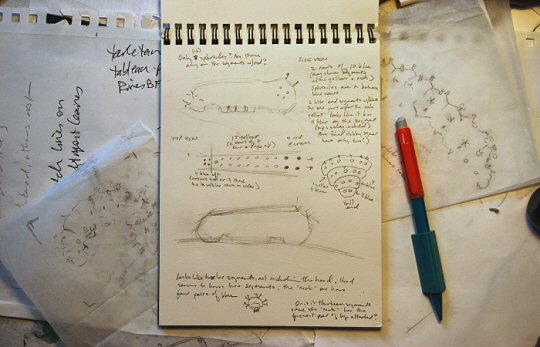
It is November; my Cecropia Summer is over.
Time to be at work in the studio.
|
| |
| |
| |
| |
Flora & Fauna Archive: photographs and tales from earlier Summers
Visit The Scarab Pages to learn about an ongoing book project (put on hold this year by about 120 caterpillars)
© Copyright 1997 - 2009 and beyond.
None of these images, or any portion thereof, may be used without written permission from the artist, Kate Brooke.
This page was last Last modified on November 17, 2009. |


